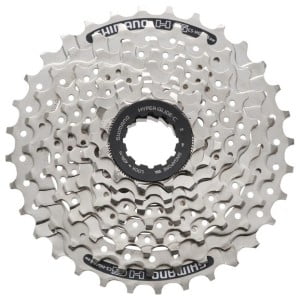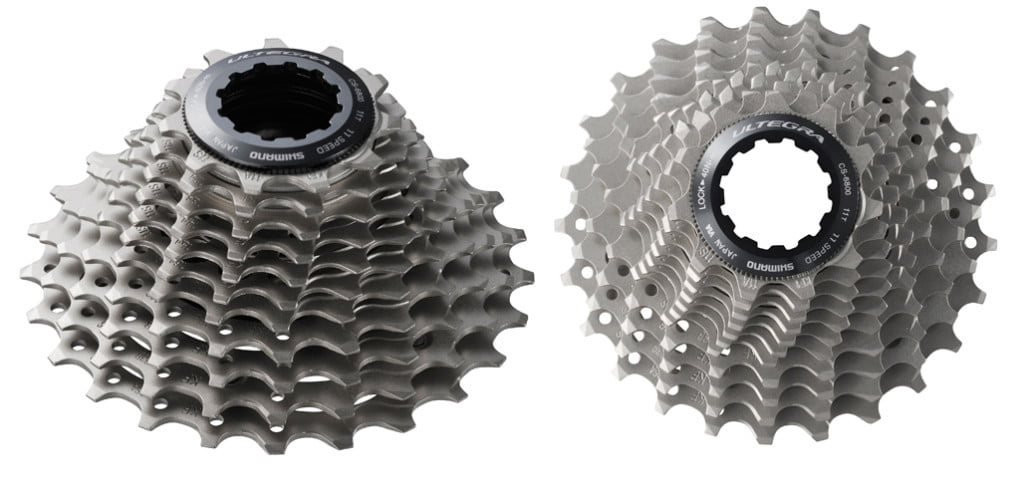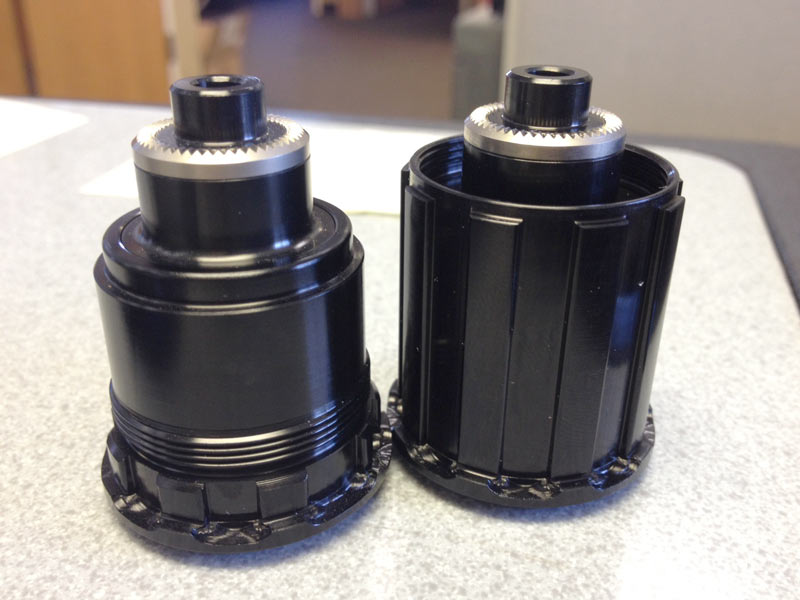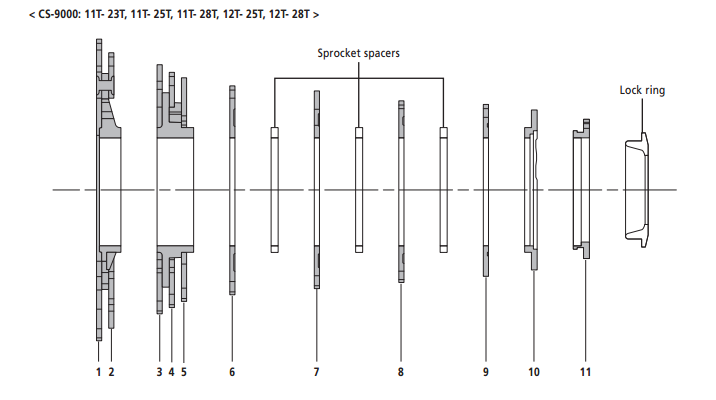This post gives a short overview of “bicycle speeds” in terms of rear sprocket (chainring) count. A series of articles explaining which sprockets can be matched with which derailleurs and shifters can be found here: Bicycle parts compatibility. For more details on cassette standards, read: Bicycle cassette (rear chainring) standards.
Bicycle rear sprockets (chainrings) – standards and differences
For detailed explanation how rear sprocket size (tooth count) affects gearing of a bicycle, read: Bicycle gear ratios – “speeds”. Here the emphasis is on the standards for sprocket spacing and thickness for various numbers of speeds – ranging from 6 to 11 in modern bicycle drivetrains.
Sprocket spacing and cassette widths
SRAM and Shimano sprockets (along with Miche, SunRace, IRD) are compatible, with no significant differences, while Campagnolo has different, incompatible dimensions, but the same tendency that the more sprockets, the tighter spacing and narrower sprockets. Where it is not noted for Campagnolo, sprocket thickness and spacing dimensions in this article are given for Shimano compatible standard.
6 “speeds”
Freewheels and cassettes with 6 sprockets usually have sprockets arranged at 5.5 mm distance (center to center of adjacent sprockets). Some (discontinued) models are spaced narrower. Sprocket thickness is 2 mm.
7 “speeds”
Sprockets arranged at 5 mm distances centre to centre. Sprocket thickness 1.85 mm.
8 “speeds”
8 speed sprockets are also 1.85 mm wide, but spaced at 4.8 mm.
Campagnolo 8-speed has sprockets spaced at 5 mm each, with sprocket thickness at 1.9 mm.

11-13-15-18-21-24-28-32
9 “speeds”
Cassettes with 9 sprockets have tighter sprocket spacing (each at 4.34 mm) as well as narrower sprockets (1.78 mm).
Campagnolo uses 4.55 mm spacing and 1.75 mm width.
10 “speeds”
Tighter and narrower. Sprockets spacing 3.95 mm, 1.6 mm wide. Sprockets this thin aren’t strong enough, so most manufacturers pack the largest 3 sprockets in a single “cage”, in order to make them stronger in these (slowest) gear ratios where most torque is applied. For a short period Shimano used to make special freehubs for 10 speed cassettes, with higher splines. 10 speed cassettes have deeper spline grooves than 8, or 9 speed ones. This is in order to make contact area larger, because it is known to happen that some 10 speed sprockets dig into freehub splines if they are (the freehub splines) made of aluminium.
Also, if 10 speed cassette is mounted on an older, 8, or 9 speed freehub, an extra spacer is necessary because 10 narrow tightly spaced sprockets will be narrower than 8 or 9 wider, widely spaced. Therefore, in order for the lockring to hold a 10 speed cassette in place, without play, an extra spacer is required.
Campagnolo uses variable spacing between individual sprockets, with each sprocket being 1.7 mm wide. Spacing varies from groupset model to model, it isn’t the same for each groupo.
11 “speeds”
About the same sprocket width (1.6 mm) as the 10 speed, but even tighter spacing, now down to just 3.74 mm. Road 11 speed cassettes require freehubs with about 1 mm wider splines, in order to accommodate all the 11 sprockets.

Placement of sprocket teeth of adjecent sprockets is carefully planned so that it allows faster gear changing.
Road 11 speed is the only system where Shimano, SRAM and other cassettes (and hubs) are compatible with Campagnolo. Chain is slightly narrower than a 10 speed one.
With 11 speed MTB cassettes, whole cluster is as wide as 10 speed one – the largest sprocket “climbs” onto the freehub end, since it has big diameter, so it doesn’t interfere with spokes (since spokes move away from the cassette at an angle, towards the wheel rim).
12 “speeds”
Newest standard. SRAM produces 12 speed cassettes for their 1x drive system (only one front chainring MTB groupsets). These cassettes require a special freehub body, just like SRAM 11 speed XD cassettes.

Right: Shimano hyperglide compatible freehub.
As of mid-2018, SRAM has introduced NX Eagle groupset, that includes 12 speed cassettes compatible with Shimano (and SRAM) standard freehubs (for 8, 9, or 10 speed cassettes). However, they don’t allow for the smallest sprocket to be smaller than 11 teeth.
As of 2018 summer, Shimano has also made their MTB 12 speed system.
Road vs MTB cassettes
Division of cassettes on road and MTB is mostly marketing. The only important factor is the number of sprockets (cogs). All other things: sprocket width, spacing, cassette width etc. are the same. Except for MTB 11 speed cassette (explained at the end of the last paragraph).
The only difference is that cassettes marketed as road cassettes have smaller difference in teeth count between adjacent sprockets. Also, MTB cassettes usually have a pretty large largest sprocket – to help climbing in off-road terrain.
E.g. typical “road” “8 speed” cassette vs typical MTB “8 speed” cassette would look like:
12-13-15-17-19-21-23-25 “road” vs
11-13-15-18-21-24-28-32 “MTB”
Note how “road” cassette has a smaller range (from 12 to 25 teeth), and smaller gaps between adjacent cogs (12-13-15… small one to two tooth jumps). “MTB” cassette has a wider range (from 11 to 32 teeth) with larger gaps between gears, up to 4 tooth jumps (…24-28-32).
Exception are MTB 11 speed cassettes that differ from road 11 speed ones. The largest sprocket is made to “climb” towards the wheel a bit, so they can fit an 8-9-10 speed freehub body, while road 11 speed cassettes require a special, wider freehub. Also 12 speed cassettes are made only for MTBs so far.
Final notes
All the systems “above” 8 speed ask for very precise rear derailleur movement. With 8 speed 5 mm spaced sprockets, 0.1 mm offset in derailleur movement isn’t even noticed.
With 9, 10 and more speeds – the chain is narrower, sprockets are tightly spaced, so a 0.1 mm offset can be significant, felt, cause bad shifting, chain skipping gears etc.
Sprockets for systems with more than 8 speeds are narrower, so they (and the appropriate chain) don’t last as long, they wear faster. With 10 and more speeds, sprockets are so narrow that they can dig into the hub splines when under pedalling load (the largest 3 sprockets are usually chained together, but the rest of the cassette is not).
When placing cassette sprockets on a freehub, one should pay attention to spacers lineup. Depending on the freehub type (and the number of speeds mounted on it), a spacer or two might be needed to mount before the cassette is placed. After that, spacers are placed between some sprockets, depending on the cassette type. If this is not aligned in proper order, there will be problems when shifting speeds.

Note how largest 2 and next 3 sprockets are placed in a single cage, for greater strength. Spacers should be placed precisely as instructed.


Hi, I believe in K.I.S.S (keep it simple stupid)
I would like to start a bike rental business near beaches, a simple one speed fat bike beach klunker shop/ rental. Rent it cheap for my no -profit bike shop rental and find a way to help homeless community bike riders. By provide free rentals, free basic tune-up service and free training. Some will have a constructive hobby to do rather than negative/bad habits by Giving out free bikes and tools if available. There is no profit in a public benefit entity. I want to see the bike community grow, Good for the heart, the community and soul, Literally and physically. I need your opinion.? SEM will donate to your website in the near future. I promise you. Bless you.
Hi Richard,
Donating time, effort and sharing knowledge can often help a lot more than money donations.
Relja